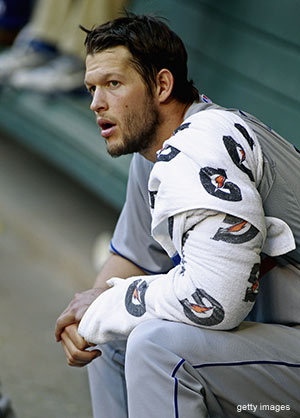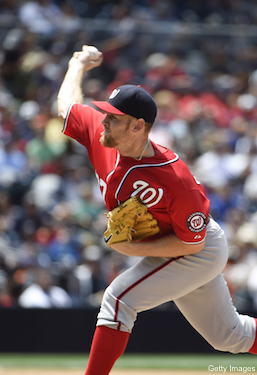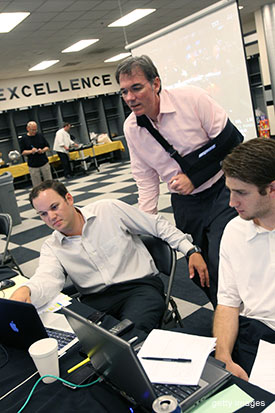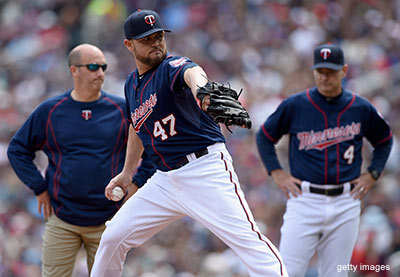There is one cure for baseball's Tommy John epidemic, and that's "Big Data."
In a decade or so, MLB teams will know what every player ate for breakfast, his heart rate on a minute-by-minute basis, whether he exerted too much effort on his left hamstring while running sprints, and they'll aggregate all of this information, billions upon billions of lines of data, into powerful decision-making that will help organizations detect and prevent injuries before they happen.
Advances in technology won't be limited to baseball, either. All major sports will begin investing in the latest and greatest versions of Data Science with the hope that the "cloud" will save ACLs, labrums and ankles alike.
In baseball, for pitchers in particular, the equation is fairly simple:
The obvious caveat when discussing the computerization of Major League Baseball is that we're years away from teams accumulating enough information to make actionable decisions on players' health. In the meantime, we're forced to rely on logic, which is actually a touchy subject in the inherently conservative world of professional sports.
But in a seemingly pedestrian article that arrived and departed from ESPN's home page in the usual cycle, the Dodgers announced in March that they entered a partnership with Irish company Kitman Labs. After successes in European sports, Kitman built a sophisticated analytics platform specifically tailored to help baseball players avoid injury.

"We want to help practitioners, we want to help athletes, we want to improve the welfare of athletes," Kitman co-founder Stephen Smith tells ThePostGame. "We want to help improve sports so that fans get to see the best players on the field week in and week out."
Smith says he's in talks with several other MLB teams about procuring its technology, but whether it's Kitman Labs or the myriad other companies destined to enter the sports technology space, it seems that organizations are finally doing the math when it comes to keeping their players healthy.
For the Dodgers part, baseball's haut monde recently allocated $200,000 to invest in startups with the hopes of finding technological gems that will increase revenue and efficiency in areas such as ticketing, concessions and of course fitness. The Dodgers are ahead of the curve, but it's safe to say that organizations are beginning to realize that injury-prevention solutions will save them millions of dollars in lost seasons.
Sticking with the Dodgers as an example, their four-year, $48 million investment in Brandon McCarthy yielded 24 innings of production before losing the veteran right-hander to a torn ulnar collateral ligament (the culprit of every Tommy John surgery). Even if he returns by June of next season -- an extremely aggressive timeline given his age (31), build (tall, slender) and injury history -- the Dodgers essentially flushed $15 million down the toilet because they had no way of knowing the inner recesses of McCarthy's elbow were damaged to the point of no return.

So what will this data suggest? What intelligence will we glean from the millions of dollars invested in machine learning algorithms and technology that only computer science majors at Stanford can comprehend?
Perhaps Dodgers VP of medical services Stan Conte said it best last year when he told ESPN baseball columnist Jayson Stark: "The truth is, it's not pitch counts. It's not fatigue. It's not velocity. It's not youth baseball. It's all of those."
In 2012 with his team sliding out of contention, Rockies GM Dan O'Dowd conducted an experiment.
During his tenure in Colorado, he had seen every starter who threw 185 to 200 innings for three consecutive years break down with a significant injury. Throughout the early 2000s, O'Dowd spent hours discussing the pros and cons of a four-man rotation and reduced pitch counts with current Phillies pitching coach and former Rockies staffer Bob McClure.

After years of research, he concluded the idea made a lot of sense and was worth a shot, especially with his team out of playoff contention. He told manager Jim Tracy that the team was going to go with a four-man rotation and 75-pitch limit on their starting pitchers, which excited the old-school Tracy as much as a three-hour class on sabermetrics.
"The mistake I made was trying to do it in the middle of the season," says O'Dowd, now an analyst on MLB Network. "If I could back up the truck, I would've done it at [different] point."
Although Project 5183 (named for the altitude of Coors Field) wasn't a rousing success, it definitely wasn't a complete failure, especially given the Rockies less-than-stellar staff (sorry, Drew Pomeranz). What's lost in history is O'Dowd's logic: No matter the ballpark, a pitcher's ERA typically rises a half point every time he cycles through an opponent's lineup during a game. In Colorado, the prospect of having to adjust to a new pitcher every at-bat was especially intriguing considering what happens when a hitter squares a ball up in Coors (adios, baseball).
But the fact is that in any ballpark, any pitcher, anytime, outs don't come easy the third time through a lineup (i.e. Clayton Kershaw vs. St. Louis in last year's NLDS) because the pitcher's arm is exhausted and professional hitters can better recognize his pitches. Again, not rocket (or data) science.

More importantly, and the main factor in O'Dowd's decision to reduce pitch counts, was the injury element.
"The No. 1 thing we recommend as far as prevention [of arm injuries], is to try and prevent fatigue," Dr. James Andrews tells MLB Network.
So here's the real question: With all that we know about the fragility of the ulnar collateral ligament, why does every team in Major League Baseball structure its pitching staffs the exact same way?
We might be 10 years away from knowing how morning oatmeal affects a curveball, but we have incredibly simple, persuasive data that suggests the way teams structure pitching staffs is archaic, both from the standpoints of injury and effectiveness.
Unless an adjustment is made, elbows and shoulders are going to continue to break down, teams will continue losing $500-plus million every season to injuries. Ninety percent of MLB organizations will continue relying on inferior talent because of an unwritten rule that states every team must have five starting pitchers, they must throw six-plus innings every start, and we must judge them on a statistic (wins) that provides very little insight into their actual effectiveness.
With all the advances in hitting (there's a book entitled Moneyball, if you're interested) and fielding (shifts, pitch-framing metrics, UZR), when will MLB teams embrace the notion that Wins, Saves and Quality Starts hold zero value in modern baseball?
Here's two things to take into account when analyzing the pitching landscape:
- Pitchers are throwing harder, which puts more strain on the UCL, and makes them more susceptible to elbow injury, especially when they throw more pitches (i.e. starters vs. relievers)
- A player's build matters. Researchers at Northwestern have found that the muscles supporting the UCL are more important than previously thought. In other words, a tall lanky pitcher (Zach Wheeler, Brandon McCarthy, Patrick Corbin, Tyler Skaggs) is at greater risk than a player with more junk in the proverbial trunk (i.e. Bartolo Colon).
Going back to Conte's point, it's important to remember that each pitcher is unique. Just because a pitcher is tall and skinny doesn't mean he's going to tear his UCL. But it's a factor that teams should be taken into account, and considering the risks, wouldn't it make more sense for a young pitcher like Corbin or Skaggs to come back and throw 120 innings their first full season back than 180?

Why does every starting pitcher need to go six innings? Why does every team, despite its personnel, all of whom have unique builds, arm slots and histories, force a starting pitcher to follow the same guidelines?
"The win stat is today's age is an outdated stat because there's too many variables that actually control whether a pitcher gets a win or not," says O'Dowd. "And I think a Quality Start is very subjective."
Assuming Stephen Strasburg pulls it together this season, Nationals fans can rest easy. They have five horses in their rotation. But what percentage of teams have five arms that can consistently produce at an elite level for six-plus innings per game?
The argument here isn't that every team needs to structure their pitching staffs differently, but that doing so, for a vast majority of MLB teams, would benefit the club from an injury standpoint and a W/L standpoint.
There are 1,200 innings in a season, so why do all teams insist on dividing them up the same way?
For example, the Twins bullpen in 2014 had a 3.73 ERA. Minnesota's starters posted a 5.06 ERA.
So why does Ricky Nolasco (5.38 ERA) need to throw 159 innings? Because he was awarded a ridiculous four-year, $49 million contract?
What was holding back relievers Brian Duensing (3.31 ERA, 54.1 innings) or Caleb Thielbar (3.40, 47.2), two lefties capable of getting out left-handed and right-handed batters, from throwing three innings every three days and accumulating 75-80 innings?

In the current structure, teams are handcuffing themselves to throw worse pitchers for longer periods of time. If they're paying a starter to "eat up innings," wouldn't it be a better use of money to get three Brian Duensings and have them throw three innings each (one time through the lineup) every two to three days?
Minus a select few, almost every single MLB team has at least one weak link in its starting rotation. Hitters salivate at the prospect of two or three at-bats against Jeremy Guthrie, but would be equally unexcited about two to three innings from Wade Davis, Luke Hochevar, Brandon Finnegan, with a kiss goodnight from Greg Holland.
The Royals bullpen is beyond filthy, but Guthrie (5.70 ERA) and Jason Vargas (5.26) devour innings because Kansas City has to have five starters and it has to throw each starter as late into a game as possible because that's what teams do.
Every club is different, but all teams pigeonhole themselves into the same rotation structure because conformity is king in professional sports.
Until it's not.
The game's most recent wrinkle, defensive shifts, started nine years ago when Tampa Bay shifted the shortstop to the right side of the diamond to combat the monster that is David Ortiz. By 2011, the number of shifts had risen to 2,464. Last year? According to Bill James, it was 13,296.
When something works in baseball, it catches on like wildfire.
"There's many times during the season where you only need four starters, then there's times when you need six starters," O'Dowd says. "That's when your bullpen guys can pick up an extra start without having to get more starters -- this industry just doesn't have enough starters."

The supply of quality two-pitch relievers is much higher than sub-4.00 ERA starting pitchers. Why pay Ricky Nolasco when you can load your roster with quality relievers, stockpile arms in AAA for a rainy day and divy up innings in a new way?
When looking back at Project 5183 and what he would have done differently, O'Dowd talks about how altering rotations takes full organizational buy-in. If he could do it over, he would have made sure every coach, trainer and front office person in the entire Rockies system embraced the rationale and wanted to move forward.
"The concept has to be embraced from ownership on down," O'Dowd says. "It's the total conceptual model that everybody has to buy-in to and I failed at getting people to buy-in, without a doubt."

Going to two, three or four starting pitchers would be a massive philosophical change for any organization, but there's a lot of talented pitchers that don't need to see a "W" or "S" next to their name in the box score to know that they did their job.
Teams have come to accept Tommy John surgery as inevitable when it doesn't have to be -- guys who throw gas (Matt Harvey, Jose Fernandez) don't need to throw 100-plus pitches every five days. Additionally, mediocre starters don't need to throw six-plus innings every five days.
By simply rethinking the most effective way to get through 1,200 innings in a season, teams can become harder to hit, save arms, and most importantly to them, save an immense amount of money.
"No one agrees with me in the industry," O'Dowd says. "This isn't going to happen in the short term, it might not even happen in my lifetime."
But it might.
Machines are great, but so is common sense.
This isn't rocket science or data science. It's logic, and it's not that complicated.
-- Tim Livingston is editor-in-chief of TheLeadSports, a free daily newsletter that concisely breaks down each day's sports news in a zero-BS manner.





